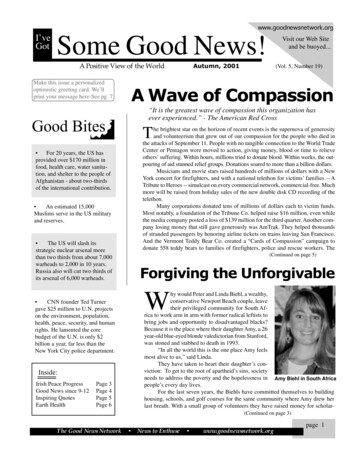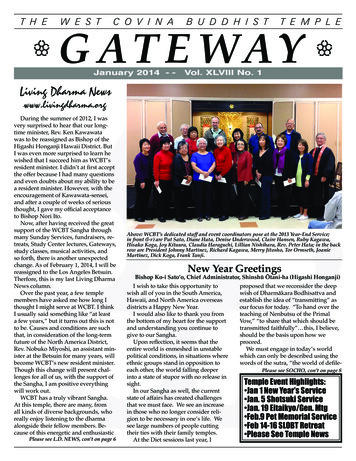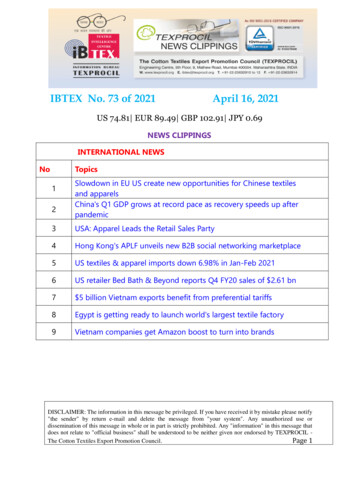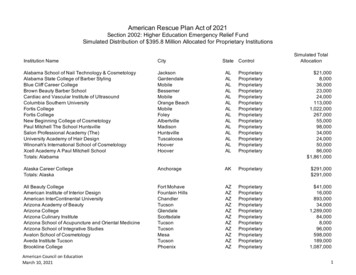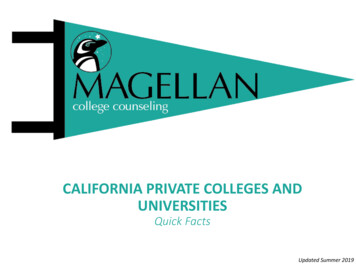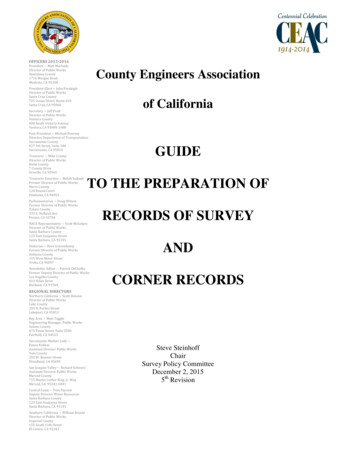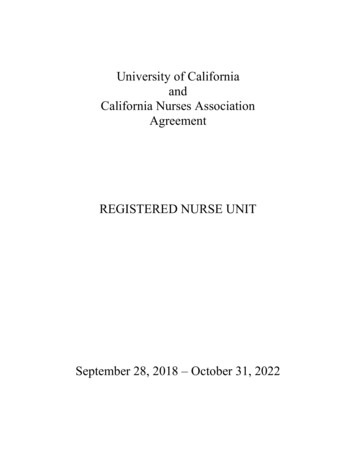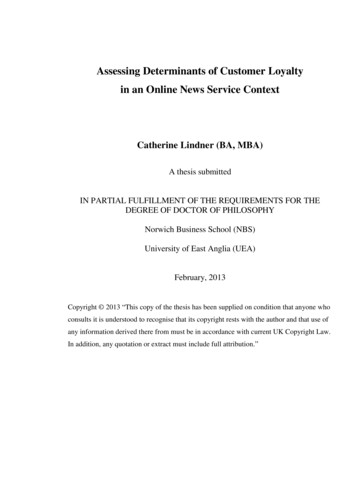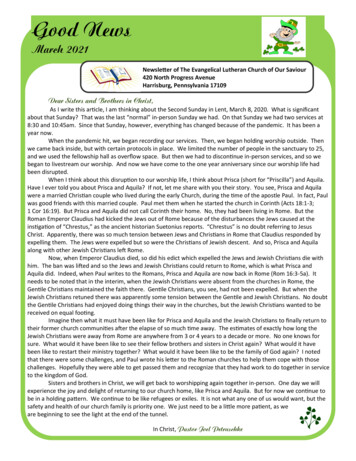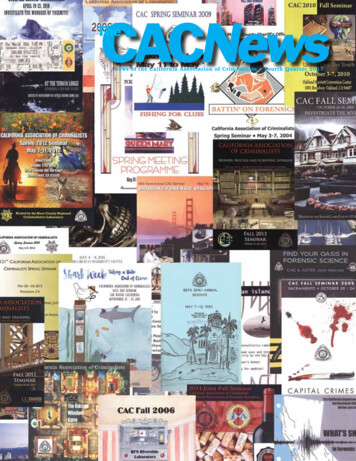
Transcription
News of the California Association of Criminalists Fourth Quarter 2017
And the Winner is.Someone once said, “Feeling gratitude and not expressingit is like wrapping a present and not giving it.” So, I amgoing to use this platform to do just that, appreciate. I appreciatethe membership for voting me in as president, attending seminarsand workshops, and contributing to our field of science. I appreciatemy superiors for allowing me time to serve the CAC. I appreciatethe agencies who volunteer to host our semi-annual meetings. Andin this upcoming seminar, in particular, I cannot wait to show myappreciation to those members receiving awards.Having served on the Awards Committee for the CAC mostof my career, nothing gave me more pleasure than receiving nominations and submitting the names to the Board of Directors forapproval. There are so many of us out there working diligently,participating in the criminalistics field, and contributing to the advancement of forensic science. These members deserve recognition.Here is a list of some awards we offer in this organization:ABC Exam AwardCAC President.nothing gave me morepleasure than receivingnominations andsubmitting the names tothe Board of Directorsfor approval. Thereare so many of us outthere working diligently,participating in thecriminalistics field,and contributing to theadvancement of forensicscience. These membersdeserve recognition.There are two fees an examination applicant must pay in orderto take the test: an application fee (a nominal fee which the CACwill always reimburse regardless of membership status) and a costlysitting fee. The American Board of Criminalistics allows each of itsmember organizations to choose one individual per year to take theexam without a sitting fee. This ABC Exam Award for the CAC isopen to any member. The Board chooses the recipient at randomfrom the list of applicants. Application period: Jul. 1 - Dec. 31.Alfred A. Biasotti Most Outstanding Presentation (MOP) AwardAll CAC members presenting at the semi-annual seminars aregraded by volunteer judges for content and delivery. The winner ofthis award receives a certificate and a 200 stipend. A Best PosterAward was also created which confers a certificate and a 50 CACcredit.Edward F. Rhodes Memorial AwardNewly employed members (less than three years) are eligiblefor this award. The recipient receives a plaque and an all-expensepaid attendance to any forensic or scientific meeting. The candidateshould be willing to give some of him or herself to the requestedevent. Application period: Jul. 1 - Dec. 31.Paul Kirk and Presidents AwardJourney-level forensic scientists (up to six years) who have hadactive contributions to the profession may be presented this award.This award provides travel expenses to and from England to attendplease turn to page 5
FOURTH QUARTER 2017Editor Meiling Robinsoneditor@cacnews.orgArt Director John Houde/Calico Press, LLC(206) ark Traughber, Eric Halsing(951) 361-5000webmaster@cacnews.orgProgram artworkA collage of CAC seminarprogram covers spanningfour decades showcases theimagination of our eventplanners.Contact the EditorThe CACNews, ISSN 1525-3090, is published quarterly(January, April, July, and October) by the CaliforniaAssociation of Criminalists (CAC).The CAC is a private foundation dedicated to thefurtherance of forensic science in both the public andprivate sectors.Please direct editorial correspondence and requests forreprints to the editorial secretary.Copyright 2017 The California Association of Criminalists. All Rights Reserved.Notice to Contributors: We publish material of interest toour readers and are pleased to receive manuscripts frompotential authors. Meetings and course announcements,employment opportunities, etc. are also solicited. Advertisements are also accepted, although a fee is charged fortheir inclusion in The CACNews. Please contact the advertising editor for further information.Submissions should be made in the form of Windowscompatible files on CD or by e-mail. Alternatively, textfiles may be saved as plain ASCII files without formatting codes, e.g. bold, italic, etc. Graphics, sketches, photographs, etc. may also be placed into articles. Please contact the editorial secretary for details.The deadlines for submissions are: December 1, March 1,June 1 and September 1.INSIDECACBits / Richard Saferstein .4Editor’s Desk: “Blood Relation”Meiling Robinson.6“Lindbergh Kidnapping: The Ladder Link”Donna Christensen.9Micro PreciousEd Jones.9Antique Microscopes on Display.12“Reasoning Through Madness: The Detective in Gothic CrimeFiction”Michelle Miranda.14“Forensic Fun from NIST”Rich Press.26
Richard Saferstein1941-20174 The CACNews 4th Quarter 2017It is with great fondness that we remember Richard Saferstein,Ph.D, AAFS Retired Fellow, who passed away on July 28, 2017. Dr. Saferstein retired in 1991 from the New Jersey State Police as Chief Forensic Scientist after heading the NJSP Forensic Science Bureau for 21years. He was a leading national expert and author in the field of forensic science and was a highly sought-after consultant, participating in amultitude of high profile cases throughout the country. Dr. Safersteinserved as an expert witness over 2000 times in nearly 150 federal andstate courts involving a variety of forensic issues. His areas of expertiseencompassed breath and blood testing for alcohol, pharmacological effects of alcohol and drugs, detection and identification of drugs in biological fluids, arson-related analysis, and the forensic examination ofblood, semen, hair, paint, fiber and glass evidence. His expertise alsoincluded review and evaluation of forensic DNA evidence.Dr. Saferstein was a prolific writer who authored numerous papersand 14 books and laboratory manuals including five books publishedby Prentice-Hall. His most notable is the standard forensic science textavailable in the field, Criminalistics: An Introduction to Forensic Science,which continues to be the leading textbook in most forensic science academic programs in the United States. Dr. Saferstein was also the editorof the leading professional reference books in forensic science- ForensicScience Handbook Vol. I, Forensic Science Handbook Vol. II, and Forensic Science Handbook Vol. III. Dr. Saferstein has also authored the book,Forensic Science: From the Crime Scene to the Crime Lab.Dr. Saferstein earned a Ph.D. in Chemistry from the City University of New York in 1970. He was elected a Provisional Member to theAAFS Criminalistics Section in 1975, promoted to a Member in 1976,promoted to Fellow in 1977, and became a Retired Fellow this year. Hewas presented with an award of merit by the AAFS in 1995 and wasthe recipient of the AAFS 2006 Paul L. Kirk Award for distinguishedservice and contributions to theDr. Saferstein’s service to the forensic sciences extended well beyond the activities of the AAFS. His name can be found in the membership rolls of numerous professional organizations, which reflected hisbroad range of professional interests. He was a member of the American Chemical Society, the International Association for Identification,the Canadian Society of Forensic Scientists, the New Jersey Associationof Forensic Scientists, the Northeastern Association of Forensic Scientists, the Mid-Atlantic Association of Forensic Scientists, the Societyof Forensic Toxicologists, the New York Microscopical Society and theEastern Analytical Symposium (EAS). Dr. Saferstein served as President of EAS in 1989.Dr. Saferstein was the Rosenblatt Memorial Lecturer in Forensic Science at Northeastern University in 1994, an advisory board member forthe Barnett Institute-Northeastern University, and a member of the editorial boards of the Journal of Forensic Identification (2001-2017), the Journalof Forensic Sciences (1984- 1994), the Microchemical Journal (1988-1995),and the Journal of Analytical and Applied Pyrolysis (1980-1984).He presented numerous forensic science seminars many of whichincluded high school teachers. He was adjunct professor at The Collegeof New Jersey where he taught an Introduction to Forensic Science forover 10 years and also taught at Widener University School of Law.Dr. Saferstein is survived by his wife, Gail, son, Neal, daughterSharon and her husband, James Brophy, grandchildren, Xavier and Gabrielle Brophy; sister, Rochelle and her husband, Bernie Nicki.— Thomas Brettell
Fisher Editorial OnlineCAC member Barry Fisher recently published an editorial in Forensic Sciences Research entitled, “A new challenge forexpert witnesses relying on subjective information.”He writes, “Forensic Scientists increasingly face challenges when testifying about pattern evidence. “Pattern evidence” here denotes fingerprint evidence, firearms, toolmarks, footwear, tire impressions, handwriting, bite marks,etc. Critics question whether experts using only subjectiveinformation can provide the court with reliable information.Detractors maintain that objective data, meaning statistics, isnecessary for the expert to form an opinion in court cases.Some critics have used the depreciatory term “junk science”to suggest that certain forensic science disciplines have littleor no validity and should no longer be used.”Read the full article 0961790.2017.1342587Inter/Micro 2018Join professional and amateur microscopists fromaround the world as they present new research on techniquesand instrumentation, environmental and industrial microscopy, and chemical and forensic microscopy. InterMicro is aninternational microscopy conference—since 1948!—Hostedby McCrone Research Institute, Chicago.CALL FOR PAPERS: McCrone Research Institute cordially invites you to give a presentation of your microscopyresearch at the 70th annual Inter/Micro conference in Chicago. View abstract submission guidelines at www.mcri.org.the upcoming conference of the Chartered Society of ForensicSciences (CSFS), formerly the Forensic Science Society, our sister organization. Application period: Jan. 1 - Jun. 30.W. Jack Cadman Award, (Application period: anytime)Anthony Longhetti Distinguished Member Award, (Application period: Jan. 1 – Jun. 30)Roger Sherman Greene III Memorial Award (Applicationperiod: anytime)These awards are for seasoned forensic scientists whohave contributed significant time and influence to the Association and the field, with the Roger Sherman Greene Awardbeing the highest award our association offers.Article I, Section 11 of the Bylaws expresses one of theobjectives of the Association: “Encourage the recognition ofthis Association and its purposes among other appropriategroups and societies.” I believe that recognition of the Association begins with the recognition of those who comprisethe Association, its members. If you believe you qualify forcertain awards or know of anyone deserving of any award,please visit the Awards page on the website or discuss thismatter with the Awards Committee to get more information.Cheers,The More Things Change.While preparing this issue’s cover art, and rootingthrough programs from dozens of past seminars, I was struckby one abstract in particular. It’s twenty-years old but couldhave been written today.—John HoudeRECAPTURING THE ESSENCE OF CRIMINALISTICSThe field of criminalistics has grown dramatically over the lastfour decades. By most indicia the growth has been an order of magnitude or more over this span of time. Today there are many morelaboratories, and the laboratories that existed then are much largeror have become systems with satellite facilities. There are certainlymany more scientists employed in the field. In addition, the technological advances which have taken place have been nothing short ofastounding. It is doubtful that an established criminalist who begana Rip Van Winkle experience, at the time when I entered this field,in 1960 would even recognize a modern forensic science laboratoryon awaking today. The physical changes have been profound. All ofthese changes relating to growth and development would seem atfirst glance to be positive and welcome. However, in my view, thereis cause for considerable concern. This paper will argue that with thegrowth of the field and advances in technology have come negativedevelopments that need to be examined. The rapidity of the growthhas resulted in a loss of focus. It can be argued that technology hasadvanced at the expense of the science of criminalistics. There hasbeen an erosion of capability with respect to scientific problem solving.Many scientists employed in crime labs around the nation don’t evenagree on an operational definition of criminalistics. We need to assesswhere we are, articulate a vision for the future, and reinvent ourselves.Peter R. De Forest, D. Crim.Fall 1997 Seminar, Irvine, CA, October 8 - 11, 1997.Visit CACNews.org forT-shirts, Outerwear,Polos and more!w w w. c a c n e w s . o r g5
WCAC Editorial SecretaryThe more I thoughtabout it, the more Irealized that we aremerely temporaryvessels carryingour genes, whichwill live on in otherliving people longafter we are dead.6 The CACNews 4th Quarter 2017hy are there so many commercials for Ancestry.com? I can’t bethe only one to notice this. It seems like during every commercial break, the television is telling me that I should be curious about myfamily history and my ancestry. And if you know me, you know that I getcurious over just about anything once the seed has been planted. Just brilliant Ancestry.com! Those commercials where average people (actors) getall teary eyed or fulfilled knowing that a particular hat is the most important hat they’ve ever owned or that they’re part Native American yes, thosecommercials have me down the rabbit hole.For me, my ancestry is pretty straightforward due to the fact that I’m anew American—first generation on my mother’s side and only second generation on my father’s side. Pretty easy to know what’s coming from where.The curiosity stems less from knowing about geographical origin, and morefrom understanding gene distribution. I have a 23andMe account and basically what I’ve learned from it is that I have 1,224 relatives ranging from50% shared DNA with my mother and father to 0.07% shared with a “fourthto distant cousin” (four or more generations between our common ancestor). How is it possible for me to have this many cousins? I know that thereare a lot of family members that I know nothing about on both my motherand father’s sides. Both of my parents are the youngest of their siblings andboth sets of grandparents were long dead before I was born. There are alot of aunts, uncles and first cousins I do not know because of the age gapbetween my parents and their eldest siblings. So feasibly, yes, there existsa considerable amount of people in the world who are genetically related tome. In general we’re genetically linked to many people through a commonancestor, but there can’t be thousands of people, right?Let’s explore. Lets go back in time about four degrees of relationshipsback on the Table of Consanguinity to your great-great-grandparents. Those16 people have contributed to the collective being that is you and you’veinherited, on average, 6% of your DNA from them. Those DNA remnantsfrom generations ago, maybe approximately 100-200 years ago, dependingon how old you are today, are still persisting today. The more I thoughtabout it, the more I realized that we are merely temporary vessels carryingour genes, which will live on in other living people long after we are dead.And as far as cousins are concerned, going up the table past four degreesof relationships, it becomes apparent that it is very plausible for me (and foryou) to have thousands of distant cousins, sharing miniscule amounts of
DNA. “No matter the languages we speak or the colour of ourskin, we share ancestors who planted rice on the banks of theYangtze, who first domesticated horses on the steppes of theUkraine, who hunted giant sloths in the forests of North andSouth America, and who laboured to build the Great Pyramidof Khufu” (Rohde, Olson, and Chang, 565).Now back to the topic at hand—consanguinity. Consanguinity is a term used to describe the relationship betweencouples that share at least one common ancestor. Canon lawof the Catholic Church forbids marriage between individualsif they are within four degrees of consanguinity. Marriagesare almost universally prohibited within the second degreeof consanguinity. And while most jurisdictions forbid marriages between first cousins, other jurisdictions, like NorthCarolina and surprisingly New York, still permit it. So interms of genetic relationship, we’re talking about permittedunions between people who share about 12% of their genetic material. I know, at this point you’re probably thinking,“Why is Mei writing about this?” Well, I’ve been thinking alot about blood lately. I just took a bloodstain pattern interpretation course and more topically, I saw an episode of apopular television show where inheritance and succession iscentral to the plotline and consanguinity influences many ofthe decisions made by characters. (If you know what showI’m writing about, and you don’t want spoilers, please skipahead to the last paragraph). For those who are current orare choosing to read on, I started thinking about this showfrom a forensic kinship analysis perspective. If first cousinsshare about 12% genetic material, what amount of sharing onaverage occurs between individuals in avunculate marriages(or partnerships)? Marriages between an aunt and a nephew(or an uncle and niece) are unions between two people whoare second-degree relatives. They share 25% of their geneticmaterial. Gross. Westeros would greatly benefit from kinshipanalysis, but then again it would deprive viewers of cringeworthy performances.In most societies, avunculate marriage is prohibitedas incest, but in others it may be legal or more accepted ascommonplace. Historically, avunculate and cousin marriageswere rife among European royal families. It was common belief that through intermarrying, royal families could preservetheir pedigree and maintain their royal heritage. However,Europe’s royal inbreeding led to the lugubrious degenerationand ultimate end to many sovereign lineages. One tragic example is the ruination of the Spanish Habsburg line (House ofAustria). After 16 generations of interbreeding, the sole heirof the Spanish Habsburg Dynasty was damaged fruit, CharlesII of Spain. Charles II of Spain was physically and mentallydisabled, and impotent. Thus, the Habsburg’s literally bredthemselves out of existence.Back to forensic kinship analysis.which is why we really care about consanguineous relationships. Common applications of kinship analysis are paternity, identifying victims of mass disasters, missing persons cases, immigrationdisputes, and familial searches. Although STR DNA profilescan be used to evaluate the probability of kinship relationships, STR-typing systems are best for evaluating first-degreerelatives. In cases where reference samples from first-degreew w w. c a c n e w s . o r g7
relatives are not available, references from distant relativesare used to identify a person. The statistical power for complex kinship testing significantly decreases compared tofirst-degree pairwise kinship analysis. Accuracy drasticallydecreases from about 95% with parent-child relationships, to72% among s
AAFS Criminalistics Section in 1975, promoted to a Member in 1976, promoted to Fellow in 1977, and became a Retired Fellow this year. He was presented with an award of merit by the AAFS in 1995 and was the recipient of the AAFS 2006 Paul L. Kirk
